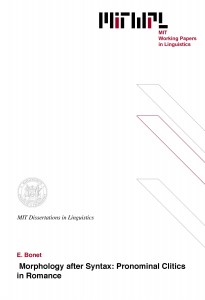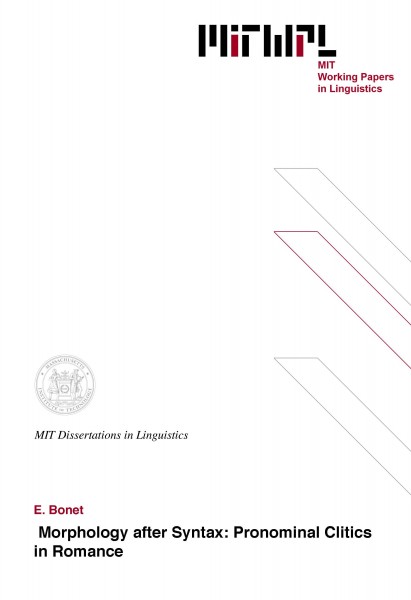Morphology after Syntax: Pronominal Clitics in Romance
E. Bonet, 1991
This dissertation is primarily concerned with non-transparent output forms in Romance pronominal clitic combinations. The position is taken that clitics constitute hierarchical structure of morphological features. Each clitic is a subset of the structure shown below:
(1) CL
ARGUMENT OBLIQUE
PERSON NEUTER GENITIVE
[+/- 1] a
In addition, clitics might contain an Agreement node, dependent on the most specific node dominated by [ARGUMENT], with the privative features [feminine] and [plural].
It is assumed, with Kayne (1975) and later work, that pronominal clitics are generated in argument position at D-structure, and are adjoined to an Infl node by S-structure. S-structure contains fully specified syntactic feature matrices, as argued for in Lumsden (1987). The morphological structures schematized in (1) are created in the mapping from S-structure to the Morphology Component (cf. Halle (1989a,b) and related work). Within the Morphology Component, morphological rules might alter, in certain contexts, the original structure assigned to a specific clitic. In this fashion most non-transparent forms are derived, predicting that an important subset of the non-transparent output forms will have the same surface form as other clitics of the language instead of becoming an arbitrary phonological sequence.
The surface order of clitics is established in the Morphology Component through the mapping to a template. Some other non-transparent forms are obtained at this point, when two clitics (or morphological features) compete for the same slot. Since only one of them can be mapped, the other one simply does not surface.
Phonological information, not present in the syntax, is introduced within the Morphology Component by spell-out rules, providing the input to PF, which deals only with phonological processes.
The type of account presented in this dissertation voids the need for filters that rule out sequences of phonologically identical sequences, criticized often in the literature.
Chapter 1 is an introduction to the framework to be developed in later chapters. Assumptions and the basic mechanisms are laid out, and some specific examples are discussed. The appendix to this chapter contains arguments against a syntactic approach to clitic order and other facts related to clitic combinations. The arguments are drawn largely from Catalan.
Chapter 2 constitutes a detailed analysis of the clitic system of Barceloní, a dialect of Catalan. This dialect contains a considerable number of non-transparent forms. In Barceloní a very clear distinction is made, in terms of morphological behavior, between [PERSON] clitics (that is first person, second person, and reflexive or impersonal clitics) and other clitics. This split is manifested also in other phenomena which are analyzed in later chapters.
Chapter 3 contains analyses of phenomena from other dialects and languages which further illustrate the framework proposed. First, the clitic system of Valencian (another dialect of Catalan) is compared to the system of Barceloní. The second section is devoted to the difference between impersonal and reflexive clitics in Italian. Finally, an important part of this chapter is devoted to the Spurious se Rule of Spanish, and its consequences in several dialects.
Chapter 4 constitutes a description of the *me lui/I-II Constraint, which forces a direct object to be third person in the presence of a dative. This constraint is claimed to be universal, and some language-specific strategies to avoid it are examined.
Chapter 5 contains some concluding remarks, including some directions for further research.
Thesis Supervisor: Morris Halle
Title: Institute Professor
<br/>
Table of Contents
Chapter 1 INTRODUCTION 10
1.1 Assumptions 12
1.2 The Proposal 15
1.2.1 Morphological Structures 15
1.2.2 The Mapping from S-structure to the Morphology 16
1.2.2.1 On the Mapping of Reflexives 27
1.2.3 Morphological Rules 32
1.2.4 On Recoverability 36
1.2.5 On Spell-out 41
1.2.6 On Linearization 45
1.3 Some Conclusions 46
1.4 Comparisons with Previous Accounts 47
1.4.1 Perlmutter (1971) 47
1.4.2 Emonds (1975), Herschensohn (1980), Burston (1983) 51
1.5 Organization of the Rest of this Thesis 54
Appendix to Chapter 1 ON SYNTACTIC APPROACHES TO CLITIC ORDER 56
1.1 Pronominal Clitics and their Uses 57
1.1.1 Pronominal Clitics as Arguments 59
1.1.2 Pronominal Clitics as Adjuncts 60
1.1.3 Inherent Clitics 61
1.1.4 Ethicals 62
1.2 Different Types of Clitics in Combination 64
1.2.1 Combinations of Two Third Person Clitics 67
1.3 Dialectical Variation 73
1.4 Summary 75
Chapter 2 THE MORPHOLOGY OF PRONOMINAL CLITICS IN
BARCELONI 78
2.1 The Mapping from S-structure to the Morphology 79
2.1.1 Separation into Fields 82
2.2 Morphological Rules 85
2.2.1 The Targets of Morphological Rules 86
2.2.2 Morphological Rules and Derivations 89
2.2.3 The Feminine 98
2.3 Linearization: The Mapping onto a Template 102
2.3.1 [PERSON] Clitics 104
2.3.2 Non-[PERSON] Clitics 107
2.3.2.1 Competing for one Slot 108
2.3.3 On Late Linearization 112
2.4 Spell-out Rules 116
2.5 Residual Issues 119
2.5.1 Extra Clitics 119
2.5.2 A Different Cooccurrence Restriction 122
2.5.3 Allomorphy in the Third Person Accusative Clitic 124
2.6 Summary
Chapter 3 FURTHER EVIDENCE AND IMPLICATIONS 129
3.1 Valencian 130
3.1.1 Arguments for Early Linearization? 133
3.1.2 On Reflexives 137
3.2 Italian 144
3.2.1 Impersonals and Reflexives 145
3.3 Spanish 150
3.3.1 On [NEUTER] 151
3.3.2 On the Spurious se Rule 153
3.3.2.1 The Spurious se Rule in Iberian Spanish 153
3.3.2.2 Consequences of the Spurious se Rule 157
3.3.2.2.1 Spurious se and Agreement Features 157
3.3.2.2.2 Se and [NEUTER] 166
3.3.2.3 Other Related Issues 168
3.4 Summary 173
Chapter 4 ON THE *ME LUI/I-II CONSTRAINT 176
4.1 A First Approximation to the *me lui/I-II Constraint 177
4.1.1 One or Two Constraints? 179
4.2 The Targets and the Constraint 183
4.2.1 Relation to Infl 186
4.2.2 The Constraint and Real Relfexives 192
4.3 Syntactic Constructions Sensitive to the Constraint 194
4.4 Three Types of Repair Strategies 200
4.4.1 Spell-out Elsewhere 201
4.4.2 Catalan hi 208
4.4.3 Object Camouflage in Georgian 214
4.5 On Hierarchies 217
Chapter 5 CONCLUDING REMARKS 222

